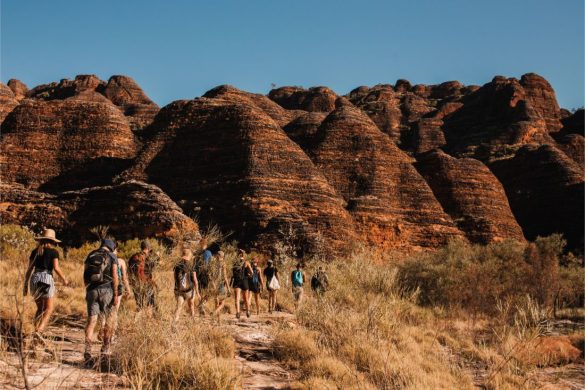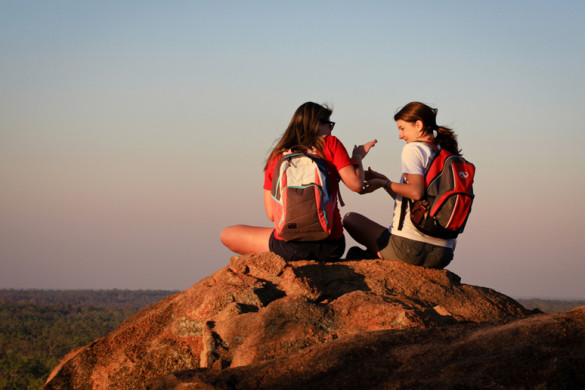This article was previously published on The Journal.
It’s hard to pinpoint the exact moment I fell in love with Tasmania.
Maybe it was when I sunk my teeth into my first meal there, the insanely creamy goats cheese and golden yolky goodness of Bryher Cafe’s baked eggs doing happy things to my tastebuds. Or maybe it happened as I picked my way along the white sands and fiery red boulders of Swimcart Beach, not another soul in sight. It could have even been at Delamere’s rustic cellar door, glass of vintage bubbles in hand and the slow, old winery dog curled warmly at my feet.
When it happened is beside the point really: the important thing is that I did fall head over heels for Tasmania, despite the fact I’d expected so little of it. In fact, along with 87.325% of Australians, I’d written off our southernmost state as small and unexciting; a strange little outcrop at the arse end of the world, most famous for its ability to grow apples and the now-extinct thylacine.
What a fool I was.
If my descriptive intro and self-admonishment haven’t already convinced you Tassie should be on your travel radar, allow me to use the following paragraphs to flesh out my case.

Tassie is filled with places to explore.
Sitting 240 kilometres south of the mainland, Tasmania has a distinct otherworldly feel to it. This is most obvious in its breathtaking landscapes, which include everything from the aforementioned white sandy beaches to snow-capped mountains and wild, rugged coastal cliffs. Aspiring (but perhaps skilfully-challenged) photographers will be happy to know these landscapes are so photogenic it’s almost impossible to take a bad picture.
SUBSCRIBE TO OUR NEWSLETTER FOR TRAVEL INSPO, COMPETITIONS, GIVEAWAYS & MORE
Best places to explore in Tasmania

Bay of Fires.
The best destinations to soak in this astonishing natural beauty are Cradle Mountain in the state’s west, and Bay of Fires, Freycinet National Park, the Tasman Peninsula and Mount Wellington in the east. If this seems like an impossibly long list to work your way through, remember that Tasmania is in fact quite small (the only correct observation I’d held about it pre-visit) and an easy two-hour drive is all you need to get between most places.
If you have the opportunity to tackle the famous 65 kilometre overland track along the steep ridges and past the tumbling waterfalls of Cradle Mountain please do: if not, the two hour Dove Lake Circuit at the base of the mountain is almost as spectacular and will take you straight past the lake’s boat-shed, one of Tassie’s most frequently photographed landmarks.
RELATED: WHY TASMANIA IS PERFECT FOR FAMILY TRAVEL
Over on the east coast, a trip to Freycinet National Park will put you smack bang in the middle of another of the state’s iconic landmarks – Wineglass Bay. The perfect crescent of white sand is bordered by turquoise waters on one side and dense bushland on the other and is splendidly secluded, thanks to the fact it’s only accessible via a two hour hike. Chances are you’ll get this place all to yourself – at least for part of your visit – unless you count the local potoroos as company.
The locals at nearby Bay of Fires claim their beaches are more impressive than Wineglass Bay, despite the fact they’re lesser known: I agree. There’s something so appealing about the vivid colours along here – the crystal blue waters, almost blindingly white sand and trademark red boulders. The abundance of marine life also sweetens the deal, with hundreds of fish easily found along the shoreline, some getting washed up with the giant tentacles of seaweed brought in by the tide. Catching dinner has never been so easy.

Freycinet.
Further south, right near Port Arthur (which is also well worth a visit, both for its eerie beauty and fascinating history), you’ll stumble upon the Tasman Peninsular. It’s wild and rugged, with millions of years of high winds and ferocious seas forming all manner of geological wonders from a fully-functioning blowhole (another one of which can be found in the charming seaside town of Bicheno) to Tasman’s Arch, Devil’s Kitchen and the world’s best example of tessellated pavement.
Mount Wellington is the final item on Tassie’s list of ridiculously beautiful landscapes, towering 1271 metres above the city of Hobart. There are stacks of hikes you can do up and around the mountain or – if you’re feeling lazy – a nice sealed road you can take to the top.
If you’re in the mood for a challenge, maybe you should consider the Point to Pinnacle half marathon that makes its way up the mountain every November. Your lungs may burst and your legs may give out but holy dooley, those views will be spectacular.
FIND THE PERFECT TRIP TO TASMANIA RIGHT HERE
Food in Tasmania
With so much hiking on the cards, you’ll be pleased to know Tasmania is home to some of Australia’s best food. Don’t believe me? Try the lamb ribs at Launceston’s Geronimo, a Bruny Island Oyster, any of the forward-thinking fine dining dishes at Hobart’s Franklin or a spiced quince and walnut tart at Jackman and McRoss and then get back to me.
Tassie’s beverage scene is similarly excellent, with vineyards like Wines for Joanie, Delamere and Spring Vale producing highly slurpable delights. On the whisky front, Lark is doing magical things with fermented rye and Bruny Island House of Whisky knows how to pull off an exceptional tasting. As a bonus recommendation, try a bottle of Willie Smith’s Organic Cider wherever you stumble across it – its makers have managed to strike the perfect balance between sweet, bitter and bubbly.
RELATED: HERE’S HOW TO SEE AUSTRALIA ON A BUDGET
Art in Tasmania

MONA.
It would be impossible to write a piece on Tasmania without mentioning MONA, arguably Australia’s best known and most controversial art gallery. Here you’ll find a wall boasting 150 moulded vaginas of all shapes, sizes and grooming practices; a machine that eats and defecates like clockwork (it also farts quite regularly, causing more sensitive observers to cover their noses and leave the room); and a couple of goldfish swimming around a carving knife in a tiny bowl. I should also mention the bulk of the gallery lives 17 metres underground, in a dark and cavernous space. Is it strange? Yes, but in the most delightful way. Unexciting? Never.
I could quite literally go on and on about Tasmania and all its glory but, for now, I rest my case. Maybe it’s time you booked a trip and started your own love affair.
Tempted? We have a plenty of small group adventures that explore beautiful Tasmania.
All images by Damien Raggett.










